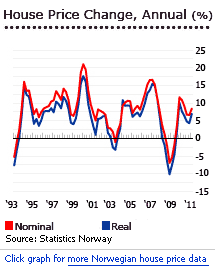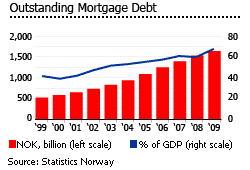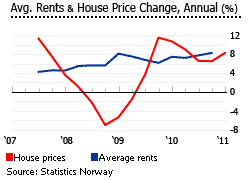Norway's strong house price surge continues

Norway’s housing market has been performing impressively. The house price index rose 8.4% during the year to the first quarter of 2011, according to Statistics Norway, or 7.5% adjusted for inflation. The first quarter’s rise was a giant leap, with the index up 5.1% q-o-q (4.5% real), in contrast to a 0.1% drop in Q4 2010.
Norway’s market began recovering in early 2009, after house prices fell from mid-2007 to 2008:
- In Oslo, house prices rose 10.9% (9.6% real) y-o-y to Q1 2011, and 5.9% (5.2% real) q-o-q.
- Bergen registered the highest annual house price increase with 12.2% (10.6% real) y-o-y to Q1, Stavanger and Trondheim also rose 10.4% (8.8% real) and 9.20% (7.7% real), respectively. Western Norway recorded the highest annual price growth among Norway’s regions, at 10.7%.
- Northern Norway had the lowest house price growth at 3.4% y-o-y.
Low interest rates have pushed property prices up across all regions and property types, after Norway emerged unscathed from the global financial crisis. Norges Bank, Norway’s central bank, started cutting key interest rates in Q3 2008 in response to the credit crunch, reducing the sight deposit rate from 5.75% to a historic low of 1.25% in Q3 2009. This led to mortgage interest rate reductions of as much as 4%, to around 3.4%-3.8% by Q3 2009.
But now, interest rates are rising again. The key policy rate was raised by 25 basis points in May 2011, to 2.25%, and is expected to rise further by year-end. Norges Bank claims the hike aims at ‘currently low’ inflation, but with core inflation only 1% in May 2011, down from 1.3% in April, this seems unlikely (a strong Norwegian Krone keeps prices in check). Possibly, the higher rates are also aimed at avoiding a housing bubble, as the risks are rising, given increasing household debt and house prices.
“Capacity utilization in the economy is rising…There are prospects that inflation will pick up over the year ahead,” says Øystein Olsen, new head of the central bank.
The unemployment rate in Norway is one of the lowest in Europe, at 3.2% in Q1 2011, down from 3.7% during the same quarter last year.
According to Bjoern Skogstad Aamo, head of the Financial Supervisory Authority of Norway, "It is…important to reduce the risk of new crises through a gradual, and not too slow, normalization of interest rates, through limits on bank housing loans, strict standards on banks´ equity and continued active supervision of property markets."
But tougher times may lie ahead. Norway’s economy grew slightly less in Q1 2011 by only 0.6% q-o-q, although it is still better than 0.3% growth in Q4 2010. Higher electricity prices dampened electricity consumption, which also led in the fall by 0.9% on the consumption of goods.
Norway’s overall GDP unexpectedly contracted in the first quarter of 2011. The economy is expected to grow by around 2.9% in 2011, according to International Monetary Fund (IMF).
House price cycles
Norway is no stranger to rapid house price increases. Since 1990, house prices have risen by more than 10% annually during six different periods:
- Q1 1994 – Q4 1994: average y-o-y growth of 13.3% (11.7% in real terms)
- Q4 1996 – Q3 1998: 12% (9.4%)
- Q3 1999 – Q3 2000: 16.8% (13.7%)
- Q2 2004 – Q4 2004: 10.4% (9.2%)
- Q1 2006 – Q3 2007: 14% (12.4%)
- Q4 2009 – Q1 2010: 11.2% (8.9%)
Two major causes of these strong house price increases:
- strong economic growth
- low interest rates
Annual price falls were observed only in three periods:
- Q1 1993 – Q2 1993: -3.2% (-5.6% in inflation adjusted-terms)
- Q2 2003: -1% (-3.2%)
- Q3 2008 – Q2 2009: -4% (-7.2%)
The average price of new detached houses in Oslo rose 166% between 2001 to 2010, to NOK 41,969 (€5,364) per sq. m.. In contrast, new detached house prices rose only 90% in Norway as a whole.
Rapidly growing mortgage market

Mortgages rose from 40% of GDP in 2000, to 68% in 2009. The mortgage market grew by 7% even in 2009, during the global financial meltdown - although this was lower than the average 2000 to 2008 annual mortgage growth of 12.6%. Most mortgages are borrowed from banks (51.44%) or mortgage companies (43.29%). Meanwhile, household gross domestic debt grew by 1.9% in the first four months of 2011, to NOK 2.16 trillion (275.9 billion), i.e., 79% of Norway’s GDP.
Housing supply

One possible reason for the strength of house prices in Norway, is that its housing market faces little oversupply. Although the number of dwellings started and completed rose during the house price boom, the increases were modest compared to countries such as Spain or Ireland. For instance, an average of 23,000 dwelling units was started from 2000 to 2003. During the boom (2004 to 2007), starts rose to an annual average of 31,000. Housing starts dropped to 24,921 in 2008, and 18,281 in 2009. There were 20,148 starts in 2010; similar to the level during the pre-boom period.

The number of dwellings completed followed a similar pattern: completions rose from an average of 22,500 dwelling units in 2001- 2004, to 28,500 units completed annually between 2005 and 2008. Completions dropped to 21,225 dwellings in 2009 and 17,446 in 2010.
Higher rent increase in cities

Average monthly rents rose 8.4% y-o-y to Q4 2010 according to a rental market survey conducted by Statistics Norway. Bergen, Trondheim, Stavanger and Tromsø had a 9.4% increase in average monthly rent during the same period; Oslo, including Bærum, had a 9.6% growth.
Owner occupancy is strongly subsidized by the state
Owner occupancy has been increasingly popular in Norway. State policy has had a strong impact:
- Preferential interest rates are offered to households through the State Housing Bank.
- Buyers can purchase municipal land at subsidized prices.
- Owner-occupiers get tax relief on mortgage interest payments.
- Owner-occupied housing is taxed at a lower effective rate than rental housing.
- Owner-occupied dwellings are capital gains tax exempt.
The long-term impact of all these measures - in 1920, about 47% of Norway’s households were renters, but by 2004 only 18% rented, and around 63% were freeholders and 14% coop-owners. In Oslo, the share of renters was a bit higher, at 29% of households.
At the same time, there is a consensus that the free market does not provide sufficient housing for the poor. In 1998, the Government agreed that the state should finance a new non-commercial rental housing sector, with the aim of building 50,000 new non-commercial rental dwellings over the next 10-15 years, located in the biggest towns, with low and regulated rents. Social rental housing made up around 15% of the 800,785 rental stock in 2001.
Many Norwegians own second homes
Only about 21% of rental units are owned by professional landlords. About 60% of rental units are either a) units inside or attached to the landlord’s primary dwelling or b) secondary dwellings let by owners in a temporary basis.
Probably due to low transaction costs and strong government support for house purchases, about 10% of households in Norway own an additional housing unit within their own country – high, compared to just 2% in the UK, and 6.5% in the US and Canada. About 50% of the secondary houses have been acquired through inheritance. Interestingly, about 50% of these households do not rent out these second flats or houses. This is probably due to the low yields prevailing in Norway, generally at 3% to 5%.
Low unemployment, lower inflation
Mainly due to high oil prices, Norway has only experienced one year of recession since 1990, in 2009, when Norway experienced a 1.5% contraction in GDP. Norway’s economy expanded by more than 5% annually between 1994 and 1997, and then from 2004 to 2007 by an average of 3% annually. Even during the economic slowdown in 2002 and 2003, annual GDP growth never fell below 1%.
The recovery of oil prices in late 2009 buoyed the economy. Norway is the world’s third largest oil exporter, and a major exporter of natural gas. So Norway’s 1.5% economic contraction in 2009 was relatively undisruptive, compared to other countries in Europe and around the world.
But now, tougher times may be coming. Norway’s GDP unexpectedly contracted in the first quarter of 2011, as high electricity prices dampened electricity consumption, leading to 0.9% fall in consumption. The economy is expected to grow by around 2.9% in 2011 according to International Monetary Fund (IMF).